The Bernina Express is one of Europe’s most celebrated train journeys, taking travelers through some of the most beautiful and dramatic landscapes on Earth. Spanning from the historic town of Chur in Switzerland to Tirano in Italy, this journey crosses the Swiss Alps, a UNESCO World Heritage Site, and showcases breathtaking views of glaciers, alpine meadows, and mountain lakes. Along the way, passengers are treated to engineering marvels like the Landwasser Viaduct and the Bernina Pass.
In this expanded guide, we will delve into every aspect of the Bernina Express, from its route and highlights to practical tips, historical significance, and why it’s a must for any traveler. Whether you’re an adventurer, a nature enthusiast, or someone looking for a relaxing yet memorable journey, the Bernina Express offers an experience unlike any other.
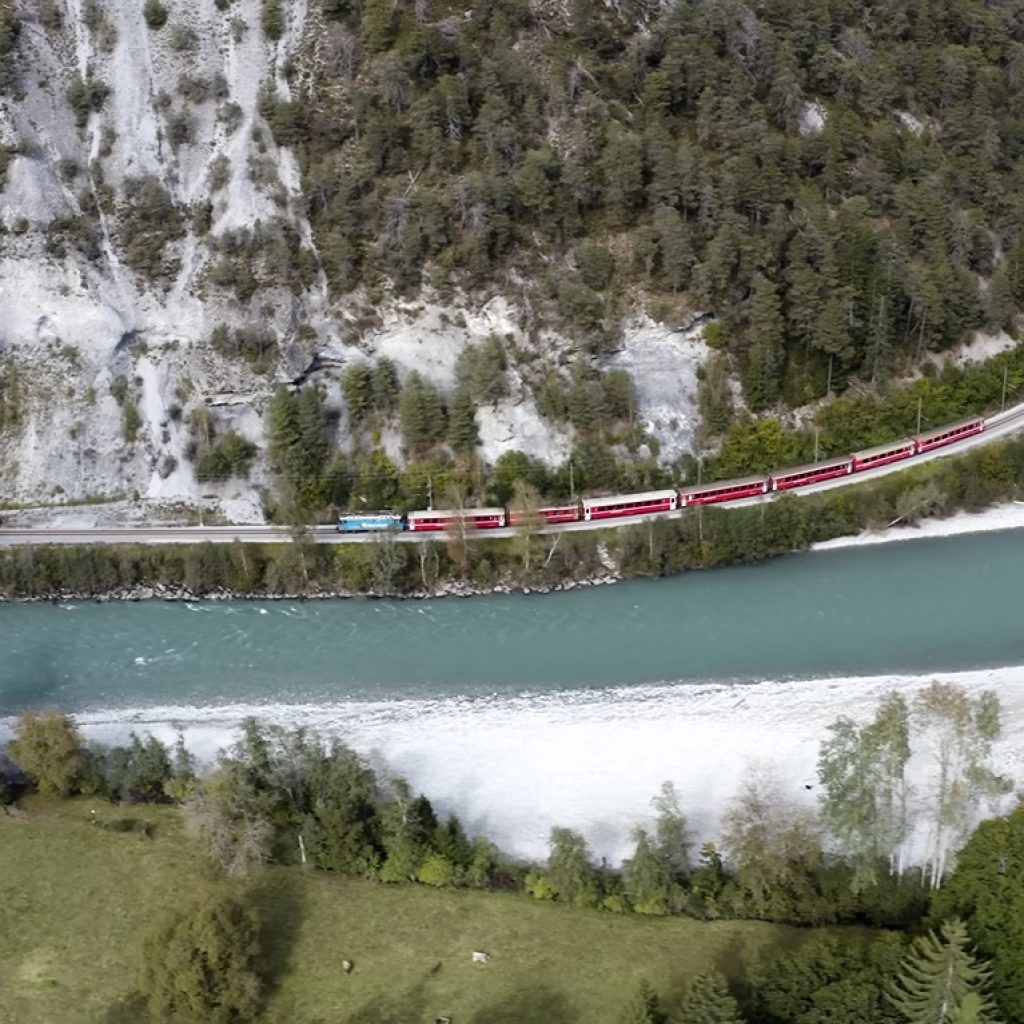
Introduction to the Bernina Express
The Bernina Express is much more than a train ride; it is a once-in-a-lifetime experience through the Swiss Alps. The train’s route from Chur to Tirano crosses some of the most scenic landscapes in Switzerland and northern Italy, offering an unparalleled panoramic experience. It traverses bridges, tunnels, and viaducts, some of which are over 100 years old, showcasing the incredible engineering achievements of the Swiss.
Why is the Bernina Express so famous? It’s not just the stunning landscapes but the train’s ability to smoothly glide through steep gradients without the need for a cogwheel mechanism, making it a unique engineering marvel. The journey is 122 kilometers long, taking approximately four hours, during which the train climbs to its highest point at the Bernina Pass at 2,253 meters and descends into the warm, Mediterranean climate of Italy’s Tirano.
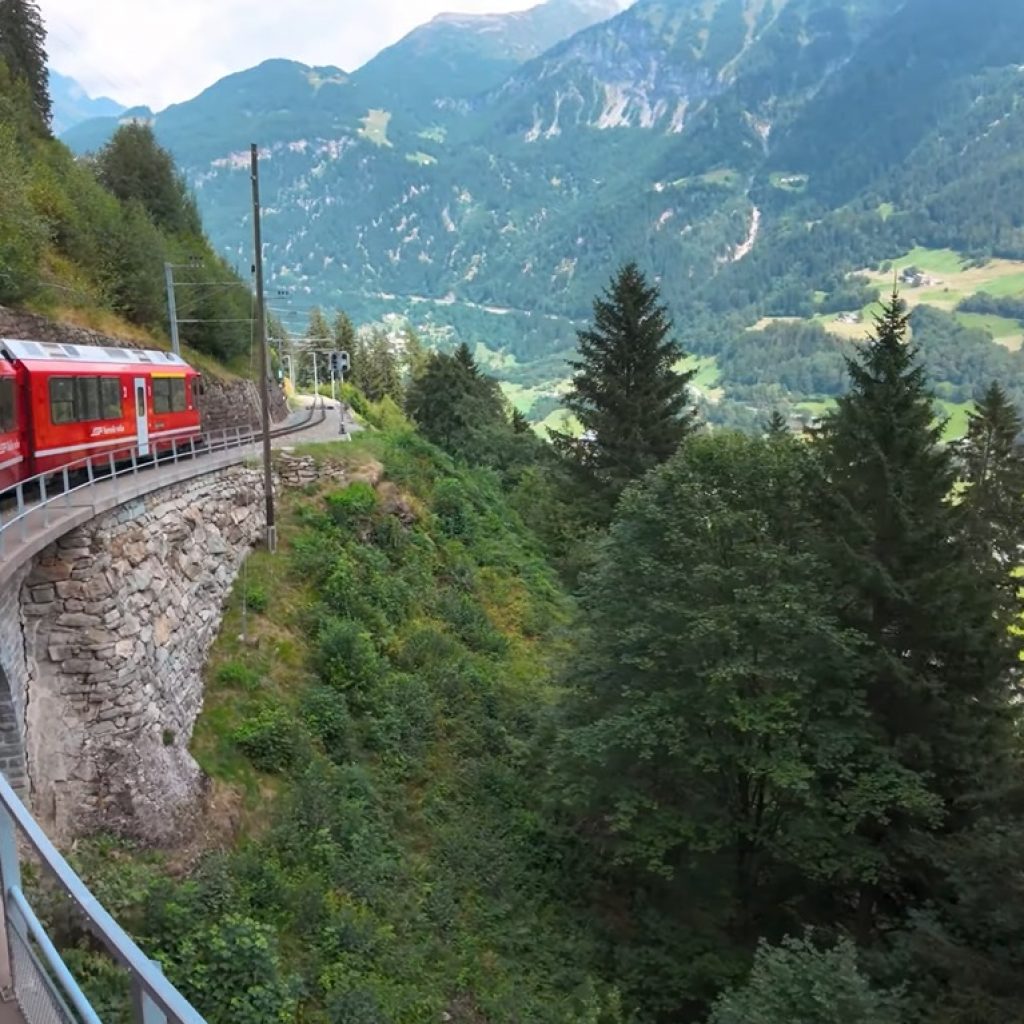
The Route of the Bernina Express
Chur – The Starting Point
The journey begins in Chur, the oldest city in Switzerland. This historical town, with its winding streets, medieval buildings, and vibrant cultural scene, is the perfect starting point for a scenic adventure. For travelers arriving a day earlier, Chur offers plenty of opportunities to explore, including the Old Town, the Bündner Kunstmuseum, and the Cathedral of Saint Mary of the Assumption.
Climbing to the Alps
From Chur, the Bernina Express begins its ascent into the Alps. As the train climbs higher, passengers are treated to increasingly stunning views of deep valleys, forests, and distant snow-capped peaks. The first major highlight is the Landwasser Viaduct, an architectural marvel that appears almost as if suspended in mid-air. The viaduct is an iconic symbol of Swiss railway engineering, with six arches spanning a deep gorge.
The Albula Railway and Landwasser Viaduct
The Albula Railway section, which leads to the Bernina Pass, is part of the Rhaetian Railway and is recognized as a UNESCO World Heritage site. As the train crosses the Landwasser Viaduct, passengers get a panoramic view of the gorge below and the mountains above. This viaduct is unique because it leads directly into a tunnel, creating a sense of awe as the train seamlessly transitions from open air to mountainside.
Preda to Bergün – Scenic Bliss
The route from Preda to Bergün is particularly famous among train enthusiasts for its multiple loop tunnels and the way the railway winds through the mountains. The Bergün area is also known for its charm and its ski resorts, which attract tourists throughout the year. During this section of the journey, passengers experience hairpin turns, bridges, and tunnels, all while surrounded by the beautiful alpine environment.
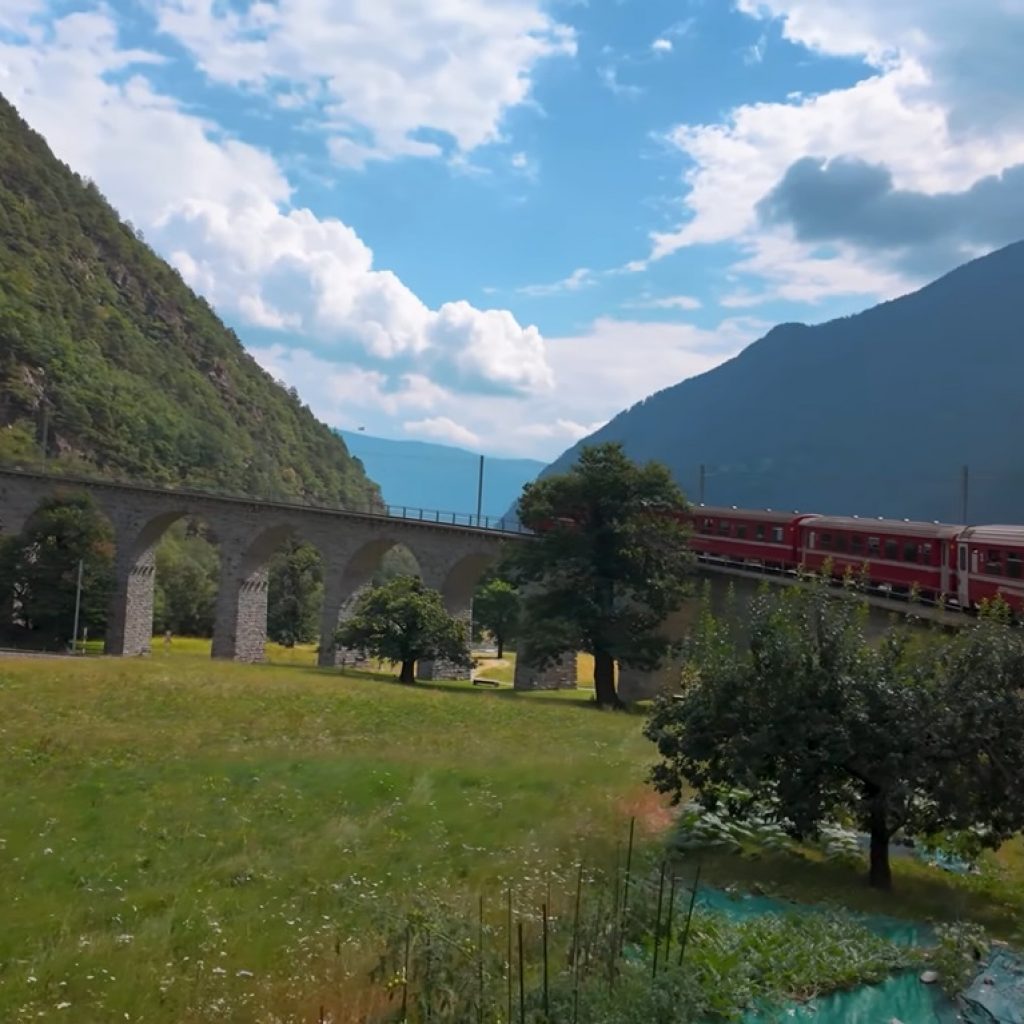
Engineering Feats of the Bernina Express
The Bernina Express is a testament to Swiss engineering prowess. Unlike many alpine railways, the Bernina route operates without the use of cogwheels, despite traversing steep gradients. This is possible due to the careful design of the track, which utilizes spirals, tunnels, and viaducts to allow the train to ascend and descend smoothly. The train’s climb to the Bernina Pass is one of the steepest adhesion railway routes in the world, with a gradient of up to 7%.
The Bernina Pass – The Highest Point
At an altitude of 2,253 meters, the Bernina Pass is the highest point on the Bernina Express route. From this vantage point, passengers can see Piz Bernina, the highest peak in the eastern Alps, towering at 4,049 meters. The journey through the Bernina Pass offers stunning views of glaciers, including the Morteratsch Glacier, and mountain lakes such as Lej Pitschen and Lej Nair.
The Brusio Circular Viaduct
One of the most photographed spots along the route is the Brusio Circular Viaduct, a spiraling viaduct that allows the train to manage the steep descent into the town of Brusio. The viaduct’s unique design showcases the ingenuity of Swiss railway engineers, and its circular shape makes for a perfect photo opportunity.
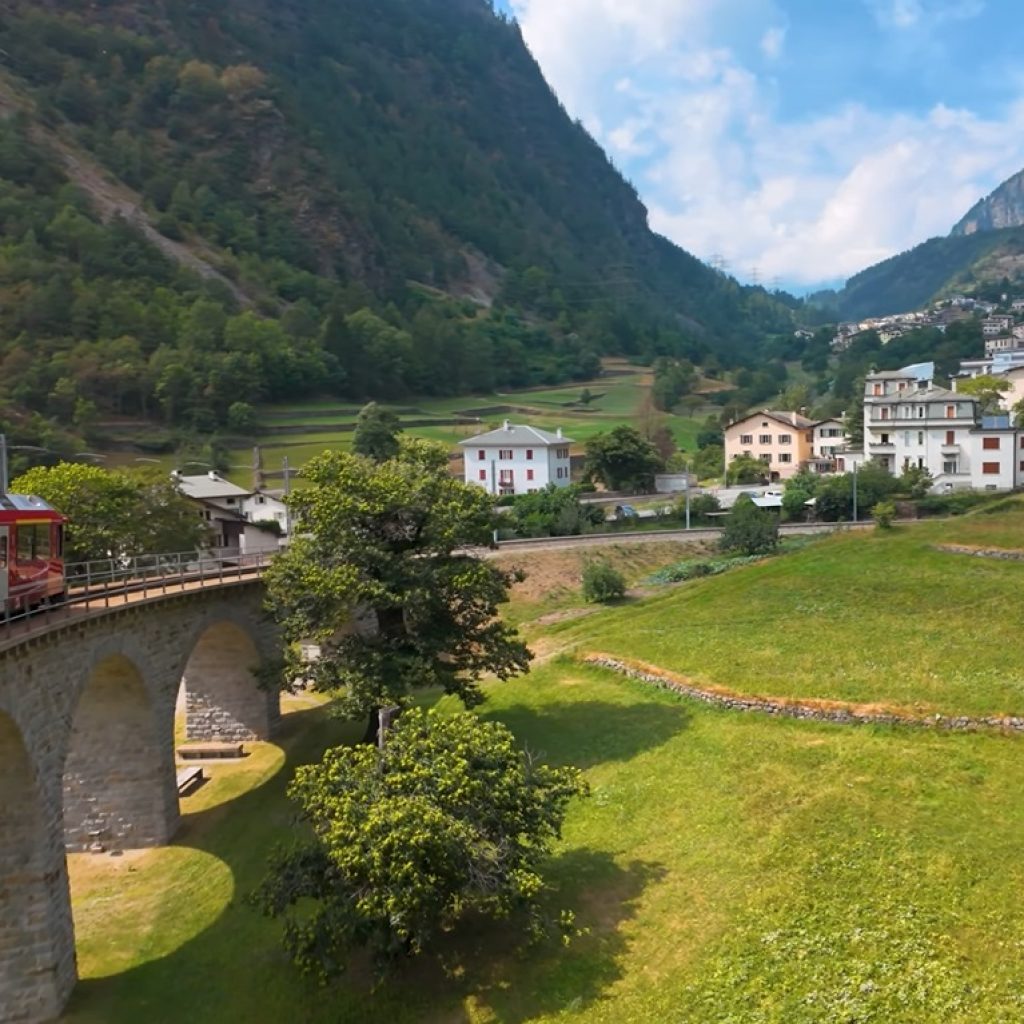
UNESCO World Heritage Status
The Bernina Express is part of the Rhaetian Railway’s Albula/Bernina Lines, which were designated a UNESCO World Heritage Site in 2008. This recognition highlights the importance of the route not only for its scenic beauty but also for its historical and technical significance. The railway is a masterpiece of civil engineering, overcoming the challenging terrain of the Alps to connect remote areas with the rest of Switzerland and Italy.
History of the Albula Line
The Albula Line, completed in 1903, was a groundbreaking project that helped connect the Graubünden region of Switzerland with other parts of the country. The line’s construction was a monumental feat, requiring over 42 tunnels and 144 bridges. Today, this section of the Bernina Express route is celebrated for its perfect harmony with the natural landscape, blending man-made structures with the rugged beauty of the Alps.
Highlights of the Bernina Express Journey
The Bernina Express journey is filled with highlights, from the engineering marvels to the natural beauty that surrounds the train at every turn. Below are some of the standout moments that passengers can expect during their trip.
The Landwasser Viaduct
As mentioned earlier, the Landwasser Viaduct is one of the most iconic features of the Bernina Express route. This six-arched stone viaduct spans the deep Landwasser Valley and leads directly into a mountain tunnel. Its dramatic positioning and architectural beauty make it a symbol of the Bernina Express experience.
Morteratsch Glacier
The Morteratsch Glacier is another key highlight, offering travelers a glimpse of the powerful natural forces that have shaped the Alps over millennia. The glacier is visible from the train as it makes its way through the Bernina Range.
The Bernina Pass
The Bernina Pass offers some of the most dramatic views of the journey. As the highest point on the route, it provides panoramic vistas of alpine lakes, glaciers, and towering peaks. In the winter, the landscape transforms into a winter wonderland, while in the summer, travelers can enjoy the vibrant greenery of the alpine meadows.
The Brusio Circular Viaduct
The Brusio Circular Viaduct is a true engineering marvel. Its spiral design allows the train to descend rapidly while maintaining stability and comfort for passengers. It’s one of the most distinctive features of the journey, and travelers often lean out of the train’s windows to capture the perfect photograph.

Crossing the Border into Italy – Tirano
After several hours of breathtaking scenery, the Bernina Express finally crosses the Swiss-Italian border and arrives in the town of Tirano. Tirano offers a delightful contrast to the alpine environments of Switzerland. This charming Italian town is known for its narrow streets, Renaissance architecture, and vibrant Mediterranean climate.
Tirano’s Attractions
In Tirano, passengers can explore the Basilica della Madonna di Tirano, a beautiful Renaissance church, or stroll through the town’s historic center. The Italian cuisine here is another highlight, with local restaurants offering traditional dishes such as pizzoccheri, a buckwheat pasta dish from the Valtellina region.
Connecting to Lake Como
For those looking to extend their journey, Tirano offers easy connections to Lake Como, one of Italy’s most famous and picturesque destinations. From Tirano, travelers can take a bus or train to Colico and then continue their journey along the shores of Lake Como, visiting towns such as Varenna and Bellagio.
Best Times to Travel
The Bernina Express offers different experiences depending on the season, making it a year-round destination for travelers. Whether you visit in the summer, winter, autumn, or spring, the journey promises stunning landscapes and unforgettable memories.
Summer
Summer is the most popular time to travel on the Bernina Express, as the weather is warm and the skies are clear, offering perfect visibility of the surrounding mountains, lakes, and glaciers. During the summer months, travelers can also enjoy hiking trails that are accessible from stops along the route, including the Morteratsch Glacier and Pontresina.
Bernina Express is a world-renowned scenic train journey that takes passengers from the picturesque Swiss town of Chur to Tirano, Italy, passing through the breathtaking landscapes of the Swiss Alps. This 122-kilometer route offers travelers unparalleled views of towering peaks, lush valleys, pristine lakes, and glaciers, all while crossing over magnificent bridges and tunnels, some of which are engineering marvels in their own right.
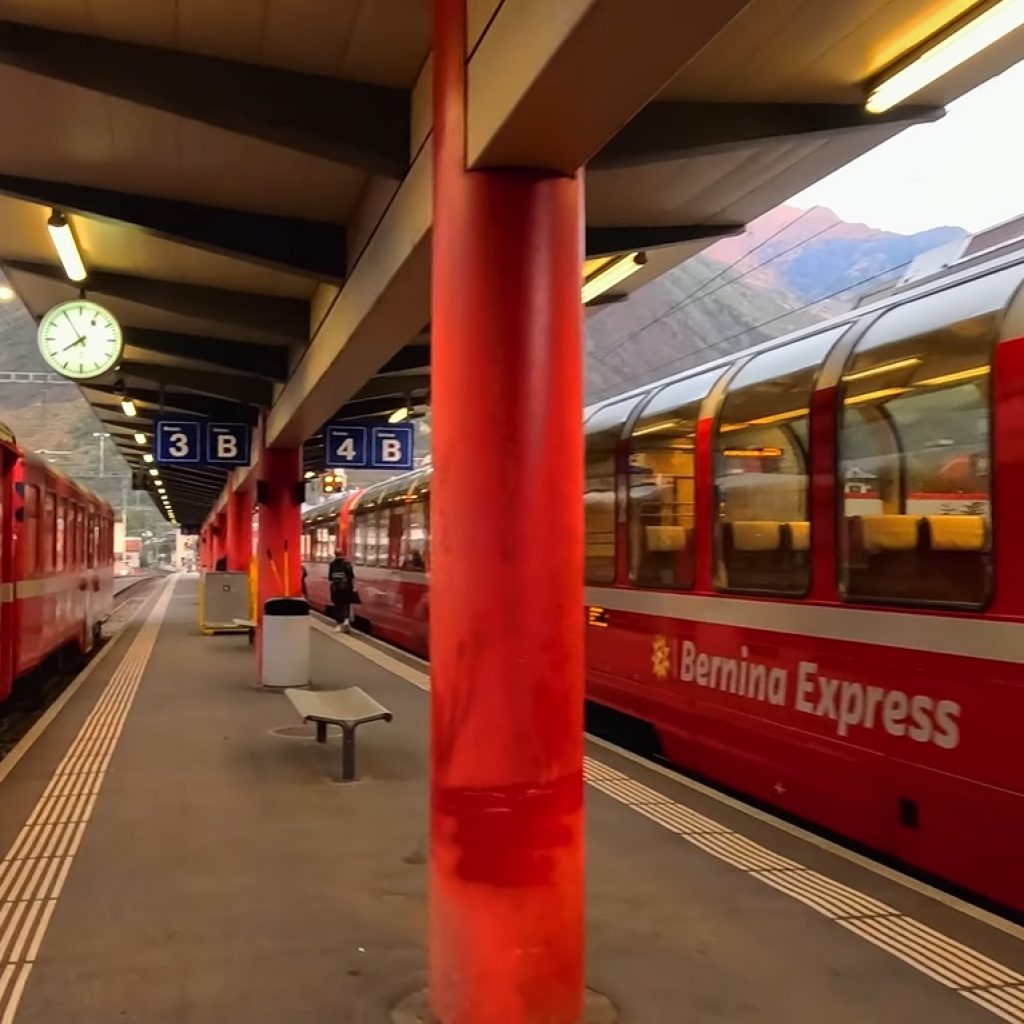
The History of the Bernina Express
The Bernina Express is part of the Rhaetian Railway (RhB), which was founded in the late 19th century. The construction of the Albula and Bernina lines, completed in 1903 and 1910 respectively, represented a significant engineering feat. The railway was designed to connect remote mountain regions with more populous areas, promoting tourism and trade. Over the years, the route has gained worldwide recognition, and in 2008, the Albula and Bernina lines were designated as UNESCO World Heritage Sites.
The vision behind the Bernina Express was to offer a route that would be both functional and beautiful, bringing people closer to the untouched beauty of the Alps. Originally a passenger and freight line, the railway evolved into a tourist attraction, drawing visitors from all over the world.
The Bernina Express Route: From Chur to Tirano
The Bernina Express starts in Chur, the oldest city in Switzerland, and follows a breathtaking route through the Alps, finishing in the charming Italian town of Tirano. The journey takes about four hours, during which the train climbs to the Bernina Pass (2,253 meters above sea level), the highest point on the line, before descending into the Mediterranean-like climate of Italy’s Valtellina region.
Chur: The Beginning of the Journey
Chur is the starting point of the Bernina Express and one of Switzerland’s oldest cities. Known for its historical architecture, Chur offers visitors a mix of medieval and modern attractions. Its old town, with cobblestone streets and charming alleys, is a great place to explore before embarking on the journey. Popular sites include the Cathedral of Saint Mary of the Assumption and the Bundner Kunstmuseum.
Climbing into the Alps: The Albula Line
The Albula section of the journey is one of the highlights of the Bernina Express route. This portion of the railway features several spiral tunnels and viaducts, including the iconic Landwasser Viaduct, an engineering marvel that spans a deep gorge and leads directly into a mountainside tunnel. The viaduct, with its six arches, offers passengers spectacular views and is one of the most photographed landmarks along the route.
As the train climbs higher, passengers will pass through the beautiful towns of Filisur and Bergün, where they can enjoy scenic views of alpine meadows, forests, and distant peaks.
The Bernina Pass: The Journey’s Pinnacle
The Bernina Pass is the highest point on the Bernina Express route, offering jaw-dropping views of glaciers and mountain lakes. Here, travelers can see Piz Bernina, the highest peak in the eastern Alps, and the Morteratsch Glacier, a massive ice field that is visible from the train. The Bernina Pass is a true highlight of the journey, with its stark beauty and panoramic views of the surrounding mountains.
The Descent into Italy: The Brusio Circular Viaduct
One of the most unique engineering features of the Bernina Express route is the Brusio Circular Viaduct, located near the Italian border. This viaduct spirals down in a perfect circle, allowing the train to manage the steep descent without losing speed or stability. It’s a remarkable sight to behold and a perfect spot for photographs.
Tirano: The Final Stop
The Bernina Express ends its journey in the Italian town of Tirano, located in the Valtellina region. Tirano’s Mediterranean climate and charming atmosphere offer a delightful contrast to the alpine environment passengers have just experienced. Visitors can explore the town’s historical center, including the Basilica della Madonna di Tirano, or enjoy a meal at one of the many local restaurants, sampling traditional Italian dishes like pizzoccheri and local wines.
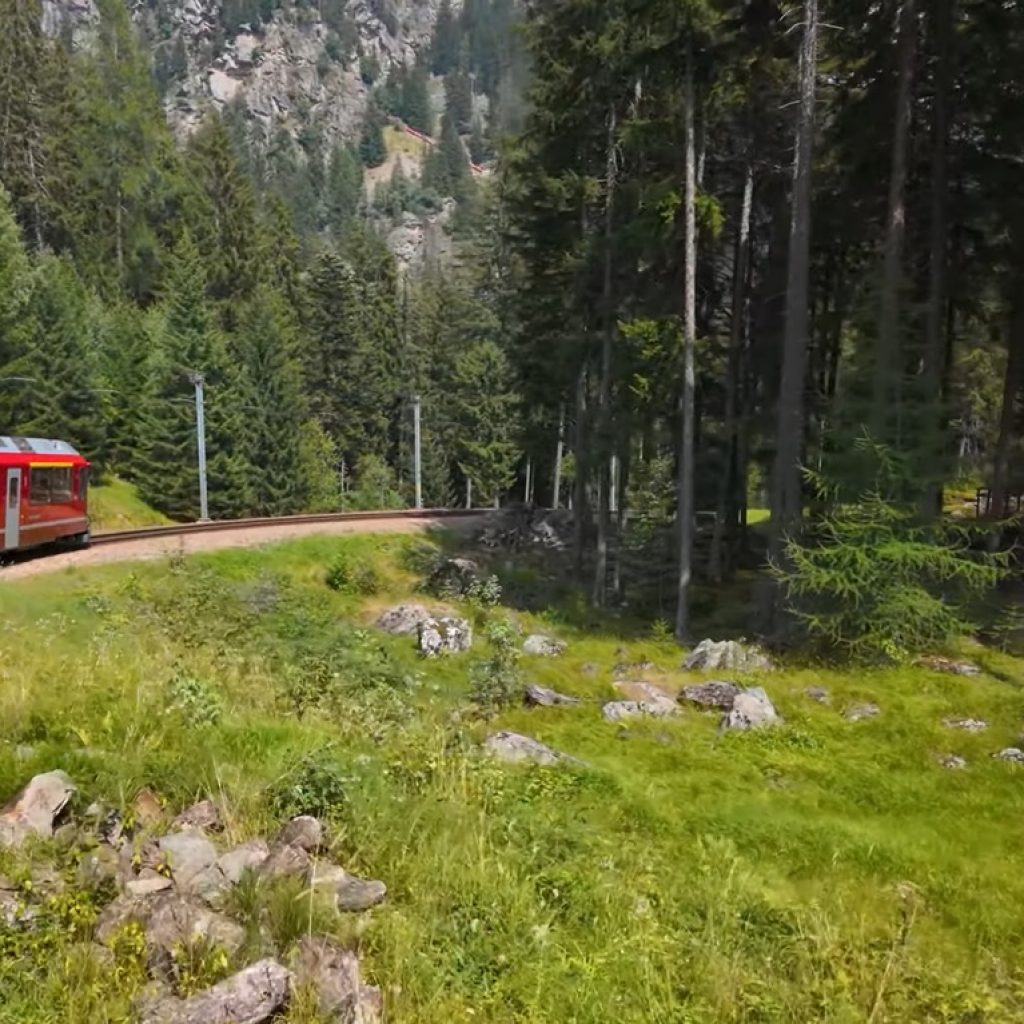
Scenic Highlights of the Bernina Express
The Bernina Express is not just a mode of transportation; it’s a scenic journey through some of the most stunning landscapes in Europe. From the towering peaks of the Alps to the serene mountain lakes, every moment on this journey offers a visual feast. Below are some of the most notable scenic highlights.
The Landwasser Viaduct
One of the most iconic structures on the route, the Landwasser Viaduct is a six-arched stone bridge that spans the Landwasser Gorge. The viaduct is 65 meters high and 136 meters long, offering stunning views of the surrounding landscape. As the train crosses the viaduct and enters a tunnel carved into the mountainside, passengers get a dramatic sense of the scale and beauty of the Swiss Alps.
Morteratsch Glacier
Visible from the train as it climbs the Bernina Pass, the Morteratsch Glacier is one of the largest glaciers in the eastern Alps. Its massive expanse of ice, framed by rugged peaks, is a breathtaking sight. Travelers can also disembark at the Morteratsch Station and hike to the glacier’s edge, getting up close to this natural wonder.
Lago Bianco and Lago Nero
At the top of the Bernina Pass, passengers will pass by two stunning alpine lakes: Lago Bianco (White Lake) and Lago Nero (Black Lake). These lakes, situated at high altitude, provide a stark contrast to each other, with Lago Bianco’s light blue waters set against the dark, reflective surface of Lago Nero. These lakes are surrounded by rugged mountain landscapes, creating an otherworldly atmosphere.
The Brusio Circular Viaduct
The Brusio Circular Viaduct is one of the most unique features of the Bernina Express route. This spiral-shaped viaduct allows the train to manage a steep descent into the town of Brusio without sacrificing comfort. The viaduct’s unusual design makes it a popular spot for photography, as passengers can capture the train as it loops around the spiral.
Practical Information for Travelers
The Bernina Express is designed to be an easy and enjoyable experience for travelers, but there are a few practical tips to keep in mind to ensure you get the most out of your journey.
Tickets and Reservations
To travel on the Bernina Express, passengers must book a seat reservation in addition to purchasing a valid train ticket. It is highly recommended to book your tickets in advance, especially during peak tourist seasons. Tickets can be purchased online through the Rhaetian Railway (RhB) website or at train stations in Switzerland.
Choosing Your Seats
The Bernina Express features panoramic windows that extend up to the roof, offering uninterrupted views of the surrounding landscapes. When booking your seat, try to choose a window seat on the side that will provide the best views. If traveling from Chur to Tirano, the left side of the train offers better views of the mountains and valleys, while the right side offers stunning views of the lakes and glaciers.
Best Time to Travel
The Bernina Express operates year-round, and each season offers a different experience. Summer provides clear skies and vibrant green landscapes, while winter transforms the scenery into a snowy wonderland. Autumn is a particularly beautiful time to travel, with the changing colors of the foliage adding an extra layer of beauty to the journey.
Photography Tips
The panoramic windows on the Bernina Express make it easy to take stunning photos, but there are a few tips to keep in mind. Avoid taking photos directly through the glass, as reflections can distort your images. Instead, try positioning your camera close to the window or use a polarizing filter to reduce glare. The best photo opportunities are at the Landwasser Viaduct, the Bernina Pass, and the Brusio Circular Viaduct.
Seasonal Variations: Summer vs. Winter Journeys
The Bernina Express offers a different experience depending on the time of year. Summer journeys are characterized by lush green landscapes, clear skies, and sparkling blue lakes. This is the best time for those interested in hiking or spending time in the alpine towns along the route.
In contrast, winter journeys offer a magical experience as the train travels through snow-covered landscapes. The mountains are blanketed in snow, and frozen lakes glisten in the winter sun. The contrast between the snowy peaks and the deep blue skies is breathtaking.





Comment (0)